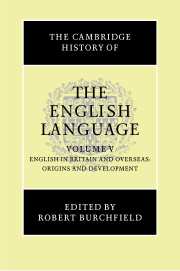Book contents
- Frontmatter
- 1 Introduction
- PART I Regional varieties of English in Great Britain and Ireland
- PART II English overseas
- 6 ENGLISH IN AUSTRALIA
- 7 ENGLISH IN THE CARIBBEAN
- 8 ENGLISH IN NEW ZEALAND
- 9 ENGLISH IN SOUTH AFRICA
- 10 ENGLISH IN SOUTH ASIA
- Glossary of linguistic terms
- Bibliography
- Index
- THE CAMBRIDGE HISTORY OF THE ENGLISH LANGUAGE
- Map 7.1 Movements of English/Creole speakers in the seventeenth century
- Map 7.2 Movements of English/Creole speakers after 1700
- References
7 - ENGLISH IN THE CARIBBEAN
from PART II - English overseas
Published online by Cambridge University Press: 28 March 2008
- Frontmatter
- 1 Introduction
- PART I Regional varieties of English in Great Britain and Ireland
- PART II English overseas
- 6 ENGLISH IN AUSTRALIA
- 7 ENGLISH IN THE CARIBBEAN
- 8 ENGLISH IN NEW ZEALAND
- 9 ENGLISH IN SOUTH AFRICA
- 10 ENGLISH IN SOUTH ASIA
- Glossary of linguistic terms
- Bibliography
- Index
- THE CAMBRIDGE HISTORY OF THE ENGLISH LANGUAGE
- Map 7.1 Movements of English/Creole speakers in the seventeenth century
- Map 7.2 Movements of English/Creole speakers after 1700
- References
Summary
Introduction
The history of English in the West Indies is unlike that of other former colonies like Australia, Canada, New Zealand and South Africa. There, English was spoken from the start predominantly by settlers from the British Isles, who passed it on to their descendants and others largely through the normal processes of language transmission: infants learned it from their elders and adults learned it through fairly close daily contact with native speakers. In the West Indies this way of transmitting English predominated only in the early seventeenth century, during the first generation of settlement of a few islands like Barbados. After that period the massive importation of slaves from Africa brought about a restructuring of English (see sections 7.1.1 and 7.1.2) that resulted in Creole, a distinct language system with words derived from English but with phonology, semantics and morphosyntax influenced by African languages and other forces. After it became established as the first language of entire communities, this creolised English was transmitted like any other language. Over the years, because of language contact phenomena, Creole came to influence (and be influenced by) the standard and regional varieties of English brought from Britain. These uncreolised varieties survived among a few relatively isolated groups made up largely of whites, and standard English survived as the language of administration and education in all the territories that remained British colonies. But to understand the forces that created the folk speech of most of the Anglophone West Indies, it is necessary to understand the social and linguistic forces that resulted in creolisation.
Keywords
- Type
- Chapter
- Information
- The Cambridge History of the English Language , pp. 328 - 381Publisher: Cambridge University PressPrint publication year: 1994
References
- 11
- Cited by



